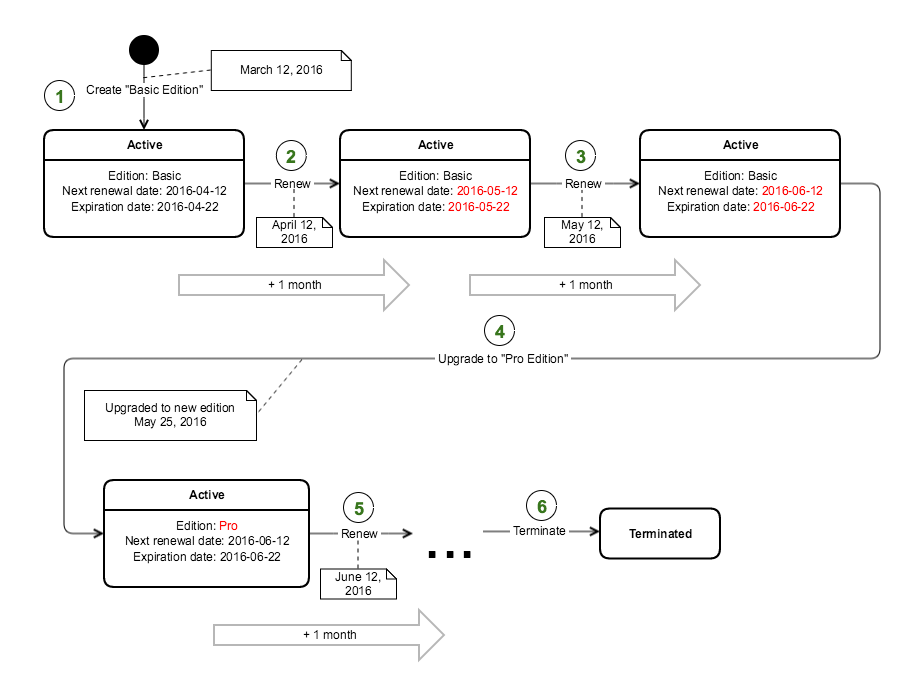License Lifecycle
The diagram below depicts a possible lifecycle of a third-party license in Key Administrator:

Step by step description of the above diagram:
-
First, a license is created as a “Basic” edition. This happens on March 12, 2016. This involves the License Creation/Renewal/Upgrade Request call (the PURCHASE action) from KA to the ISV endpoint.
-
The next license renewal date is evaluated as the creation date + 1 month, which is April 12, 2016. This is the date when the license should be renewed (i.e., prolonged for the next 1 month).
-
The license expiration date is evaluated as the creation date + 1 month + 10 days, which is April 22, 2016.
Note: If renewal is not possible (this may happen if the ISV endpoint is unavailable, or there are network issues that prevent successful connection to the ISV endpoint), then KA will repeat attempts to renew the license the next day after the “planned” renewal date, and then again and again during 10 days, until either the license is successfully renewed or the license expiration date is reached. In the latter case, the license becomes “expired” and no further attempts to renew it are made.
-
-
The license is renewed by 1 month. This involves the License Creation/Renewal/Upgrade Request call (the RENEW action) from KA to the ISV endpoint.
- The next renewal date is shifted 1 month ahead, which is May 12, 2016.
- The expiration date is shifted 1 month ahead, which is May 22, 2016.
-
The license is renewed by 1 month again. This involves one more License Creation/Renewal/Upgrade Request call (the RENEW action).
- The next renewal date is shifted to June 12, 2016.
- The expiration date is shifted to June 22, 2016.
-
The License is upgraded from the “Basic” to the “Pro” edition. This involves the License Creation/Renewal/Upgrade Request call (the UPGRADE action).
-
The license dates remain unchanged.
-
The license body is updated with a newer data returned from the ISV endpoint. Now, the license body contains a key that will unlock the “Pro” functionality for the end user.
Note: Upgrade of a third-party license makes sense if there are multiple sales options available. So if a customer has initially purchased a license for the “lowest” option, they can upgrade their license to a “higher” option later. Example: Bronze -> Silver -> Gold.
-
-
The license is renewed by 1 month again. This involves the License Creation/Renewal/Upgrade Request call (the RENEW action).
- The next renewal date is shifted to July 12, 2016.
- The expiration date is shifted to July 22, 2016.
-
Finally, the license is terminated. This involves the License Termination Request call.
Note: Please note that the License Creation/Renewal/Upgrade Request calls to the ISV endpoint are also used to update the body of the license record stored in Key Administrator. The License Termination Request call is not used for this purpose.